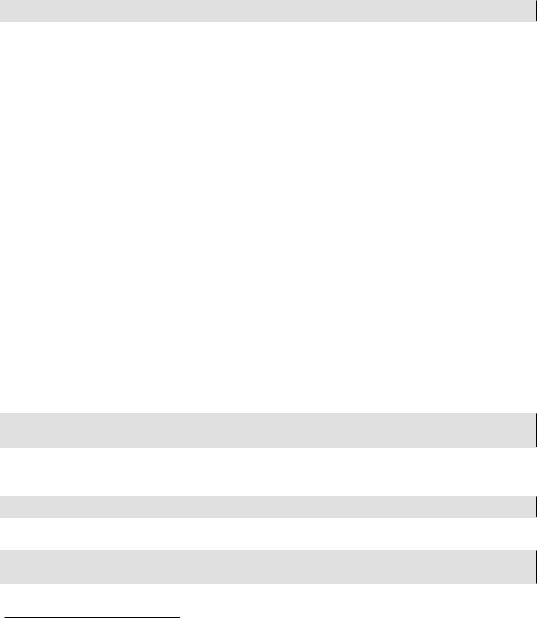
epwzf20
.pdf
Easy PHP Websites with the Zend Framework |
18 |
|
|
Try as one may, a typical view will almost certainly not be devoid of PHP code. In fact, as you'll see in later chapters, even when using frameworks you'll still use simple logic such as looping mechanisms and if statements to carry out various tasks, however the bulk of the complex logic will be hosted within the third and final tier: the controller.
The Controller
The third part of the MVC triumvirate is the controller. The controller is responsible for processing events, whether initiated by the user or some other actor, such as a system process. You can think of the controller like a librarian, doling out information based on a patron's request, be it the date of Napoleon's birth, the location of the library's collection of books on postmodern art, or directions to the library. To do this, the librarian reacts to the patron's input (a question), and forms a response thanks to information provided by the model (in this case, either her brain, the card catalog, or consultation of a colleague). In answering these questions, the librarian may dole out answers in a variety of formats (which in MVC parlance would comprise the view), accomplished by talking to the patron in person, responding to an e-mail, or posting to a community forum.
A framework controller operates in the same manner as a librarian, accepting incoming requests, acquiring the necessary resources to respond to that request, and returning the response in an appropriate format back to the requesting party. As you've probably already deduced, the controller typically responds to these requests by invoking some level of logic and interacting with the model to produce a response (the view) which is formatted and returned to the requesting party. This process is commonly referred to as an action, and they're generally referred to as verbs, for example "add game", "find friend", or "contact administrator".
MVC in Action
So how do these three components work in unison to power a website? Consider a scenario in which the user navigates to GameNomad's video game listing for the PlayStation 3 console (http://gamenomad.wjgilmore.com/games/console/ps3). The model, view, and controller all play important roles in rendering this page. I'll break down the role of each in this section, interweaving the explanation with some Zend Framework-specific behavior (although the process is practically identical no matter which MVC-based web framework solution you use):
•The Controller: Two controllers are actually involved with most requests. The front controller is responsible for routing incoming requests to the appropriate application controller which is tasked with responding to requests associated with a specific URL. The controller naming convention and class structure usually (but is not required to) corresponds with the URL structure, so the URL http://gamenomad.wjgilmore.com/games/console/ps3 maps to an application controller

Easy PHP Websites with the Zend Framework |
19 |
|
|
named Games. Within the Games controller you'll find a method (also known as an action) named console which is passed the parameter ps3. The console action is responsible for retrieving a list of video games associated with the specified console, in this case the PS3, and then passing that list to the associated view. The video games are retrieved by way of the model, discussed next.
•The Model: As you'll learn in later chapters, GameNomad's model consists of a number of objectoriented classes, each representative of a data entity such as a gaming console, video game, or user account. Two models are actually required to retrieve a list of games supported on the PS3 console, namely Console and Game. By using the Console class to create an object representative of the PS3 console, we can in turn retrieve a list of all video games associated with that console, making this list available to the controller as an array of Game objects. Each Game object contains attributes which are named identically to the associated database table's columns. Therefore the Game object includes attributes named name, price, and description, among others. Don't worry
about the mechanics behind this process, as you'll be introduced to this subject in great detail in later chapters.
•The View: Once the controller receives the array of Game objects back from the model, it will pass this array to the view, which will then iterate over the objects and embed them into the view template. Doing this will logically require a bit of PHP syntax, but only a looping mechanism such as a foreach statement and basic object-oriented syntax.
Frameworks Alleviate Overhead Associated with Common Activities
Web frameworks were borne from the understanding that all dynamic websites, no matter their purpose, share common features which can be abstracted into generally reusable implementations. For instance, almost every website will need to validate user input, communicate with a data source such as a relational database, and rely upon various configuration settings such as mail server addresses and other data such as API developer keys. A web framework removes many of the design decisions you'll need to make regarding how to approach data validation and configuration data management by embracing two powerful paradigms known as convention over configuration and staying DRY.
Convention Over Configuration
The number of decisions a developer must make when starting a new project is seemingly endless. Conclusions must be drawn regarding how approaches to tasks such as manage templates and configuration parameters, validate forms, and cache data and static pages, to say nothing of

Easy PHP Websites with the Zend Framework |
20 |
|
|
more mundane decisions such as fileand database table-naming conventions, documentation processes, and testing policy. Making matters worse, it's not uncommon for a developer to vary the implementation of these decisions from one project to the next, introducing further chaos into the development and maintenance process.
Frameworks attempt to reduce the number of decisions a developer has to make throughout the development process by advocating an approach of convention over configuration. In reducing the number of decisions you have to make by offering implementation solutions right out of the box, you'll logically have more time to spend building those features which are specific to your application's problem domain. As you'll learn in the chapters that follow, the Zend Framework removes the bulk of the decisions you'll need to make regarding all of the matters mentioned in the previous paragraph. I believe this alleviation of uncertainty is one of the strongest points to consider when weighing the advantages of a framework against creating a website from scratch. Ask yourself, should you be spending valuable time doing the middling tasks which will invariably come up every time you set out to create a new website, or should you simply let a framework do the thinking for you in those regards while you concentrate on building the most compelling website possible? I think you know the answer.
Staying DRY
Avoiding repetition within your code, also known as staying DRY (Don't Repeat Yourself), is one of programming's oldest and most fundamental tenets, with constructs such as the function having made an appearance within even the earliest languages. Frameworks embrace this concept on multiple levels, notably not only allowing you to reduce redundancy within the application logic, but also within the presentation. For instance, the Zend Framework offers a feature known as a view helper which operates in a manner similar to a function, and is useful for eliminating redundancy within your page templates.
As an example, GameNomad allows registered users to assign a star rating to various technology products. This starred rating is displayed as a series of one to five star icons, and appears not only on the product detail page, but also as a sortable visual cue within category listings. The average rating will be stored in the database as an integer value, meaning some logic is required for converting that integer value into a corresponding series of star icons. While the logic is simplistic, it's nonetheless significant enough that avoiding repeating it throughout your application would be ideal. You can avoid the repetition by bundling this logic within a view helper, and then referencing that view helper much like you would a PHP function within your presentational code. Contrast this with redundantly embedding the logic wherever needed within the website, and then struggling to update each repetitive instance following a decision to update the location of your website images. You'll learn how to create and implement both action and view helpers in Chapter 3.

Easy PHP Websites with the Zend Framework |
21 |
|
|
Frameworks Provide a Variety of Libraries
Beyond helping you to quickly surpass the myriad of implementation decisions which need to be made with the onset of each project, many mainstream frameworks provide a wide assortment of libraries which assist in the implementation of key features such as database integration and user authentication. In this section I'll provide three examples of the power these libraries can bring to your projects.
Database Integration
The practice of repeatedly jumping from one language such as PHP to SQL within a web page is a rather inefficient affair. For instance, the following sequence of statements is something you'll typically encounter in a PHPand MySQL-driven web page:
$sql = "SELECT id, platform_id, title, price FROM games ORDER BY title"; $query = $db->prepare($sql);
$query->execute(); $query->store_result();
$query->bind_result($id, $platform_id, $title, $price);
What if you could write everything in PHP? Using the Zend Framework's Zend_Db component, you can achieve an identical result while foregoing altogether the need to write SQL statements:
$game = new Application_Model_Game(); $query = $game->select();
$query->from(array('id', 'platform_id', 'title', 'price')); $query->order('title');
$result = $game->fetchAll($query);
This programmatic approach to interacting with the database has an additional convenience of giving you the ability to move your website from one database to another with minimum need to rewrite your code. Because most frameworks abstract the database interaction process, you're free to switch your website from one supported database to another with minimum inconvenience.
User Authentication
Whether your website consists of just a small community of friends or is an enormous project with international reach, chances are you'll require a means for uniquely identify each user who interacts with your site at some level (typically done with user accounts). Zend_Auth (discussed in Chapter 8) not only provides you with a standardized solution for authenticating users, but also provides you with interfaces to multiple authentication storage backends, such as a relational database, LDAP, and OpenID. Further, while each backend depends upon custom options for configuration, the

Easy PHP Websites with the Zend Framework |
22 |
|
|
authentication process is identical for all solutions, meaning that even when switching authentication solutions you'll only have to deal with configuration-related matters.
Web Services
Today's website is often hybridized a construct created from the APIs and data of other online destinations. GameNomad is a perfect example of this, relying upon the Amazon Associates web Service for gaming data and the Google Maps API for location-based features, among others. Without this ability to integrate with other online services such as these, GameNomad would be a far less compelling project.
While many of these services are built using standardized protocols and data formats, there's no doubt that writing the code capable of talking to them is a time-consuming and difficult process. Recognizing this, many frameworks provide libraries which do the heavy lifting for you, giving you the tools capable of connecting to and communicating with these third-party services. For its part, the Zend Framework offers Zend_Gdata, for interacting with Google services such as Book Search, Google Calendar, Google Spreadsheets, and YouTube. You'll also find Zend_Service_Twitter, for talking to the Twitter service (http://www.twitter.com/), Zend_Service_Amazon, for retrieving data from Amazon's product database through its web Services API (http://aws.amazon.com/ ), and Zend_Service_Flickr, for creating interesting photo-based websites using Flickr (http:// www.flickr.com/), one of the world's largest photo sharing services.
Test-Driven Development
Suffice to say that even a total neophyte is acutely aware of the programming industry's gaffe-filled history. Whether we're talking about last Tuesday's emergency security fix or the high-profile crash of the Mars Orbiter due to a simple coding error, it seems as if our mistakes are chronicled in far more detail than those made within other professions. And for good reason, given that computing affects practically every aspect of people's lives, both personal and professional.
Given the significant role played by today's computing applications, why are programmers so seemingly careless? Why does the industry remain so prone to blunders large and small? Although I'd love to offer some complicated scientific explanation or convincing conspiracy theory, the answer is actually quite elementary: programming is hard.
So hard in fact, that some of the professional programming community has come to the grips with the fact that mistakes are not only likely, but that they are inevitable. They have concluded that the only reasonable way to lessen the frequency of mistakes creeping into the code is by integrating testing into the development process, rather than treating it as something which occurs after the

Easy PHP Websites with the Zend Framework |
23 |
|
|
primary development stage is over. In fact, a growing movement known as test-driven development emphasizes that tests should be written before the application itself!
To help developers out with the testing process, the Zend Framework comes with a component called Zend_Test which integrates with the popular PHPUnit testing framework. Using this powerful combination, you can create tests which verify your website is working exactly as intended. Further, you can automate the execution of these tests, and even create a variety of reporting solutions which provide immediate insight into the proper functioning of your site.
I believe this to be such an important part of the development process that subsequent chapters conclude with a section titled "Testing Your Work". This section presents several common testing scenarios which relate to the material covered in the chapter, complete with a sample test. Further, Chapter 11 is entirely devoted to the topic of configuring PHPUnit to work with Zend_Test.
Hopefully this opening section served as a compelling argument in favor of using a framework instead of repeatedly building custom solutions. And we've hardly scratched the surface in terms the advantages! My guess is that by this chapter's conclusion, you'll be wondering how you ever got along without using a framework-centric approach.
Test Your Knowledge
Test your understanding of the concepts introduced in this chapter by answering the following questions. You can find the answers in the back of the book.
•Identify and describe the three tiers which comprise the MVC architecture.
•How does the concept of "convention over configuration" reduce the number of development decisions you need to make?
•Name two ways the Zend Framework helps you keep your code DRY.

Chapter 2. Creating Your First
Zend Framework Project
Getting started building your first Zend Framework-powered website is surprisingly easy thanks to a great utility called zf which not only automates the process of creating new Zend Framework applications, but also automates the generation of key project components such as controllers, actions, models, and views. In this chapter I'll show you how to get started using the framework by guiding you through the framework installation and configuration process, followed by a thorough introduction to the powerful zf tool. After creating your first project, I'll help you navigate through the various directories and files comprising the default project structure, and show you how to generate project controllers, actions, and views. Following that, you'll learn how to pass and retrieve data from one controller action to another using the GET and POST methods, in addition to modify the framework's default URL routes behavior to your specific needs. Finally, I'll present several examples which demonstrate how to test various aspects of the features introduced in this chapter.
Downloading and Installing the Zend Framework
Open your browser and navigate to http://framework.zend.com/download/latest. Scroll to the bottom of the page where you'll find links to the full and minimal versions of the Zend Framework. I recommend downloading the full version as it contains everything you could possibly need to follow along with the rest of this book, and a whole lot more. Download the tar.gz or zip package depending on your operating system's capabilities (the ZIP format is typical for Windows users, whereas the TAR format is common for Linux users, although you may be able to use either depending on what decompression software is available on your computer).
Tip
If you're familiar with Subversion, consider retrieving the latest stable version by checking the project out from Zend's Subversion repository. In doing so you'll be able to easily update your framework source files to the latest stable version using Subversion's UPDATE command.
Within the decompressed directory you'll find a directory named library. The library directory contains the files which together make the Zend Framework run. Because you'll likely soon be in the position of simultaneously building or maintaining multiple Zend Framework-driven websites, I recommend placing this directory within a location where it won't later be disturbed, and then add this location to PHP's include_path configuration directive. For instance, if you store the

Easy PHP Websites with the Zend Framework |
25 |
|
|
library directory in /home/wjgilmore/src/zfw110/library then you should open the php.ini configuration file and add the path to your include_path directive like this:
include_path = ".:/usr/share/php/:/home/wjgilmore/src/zfw110/library"
Once the change has been made, save the file and restart the web server.
Configuring the zf Tool
One really interesting feature of the Zend Framework is a component known as Zend_Tool_Framework. This component acts as an API of sorts to many features of the framework, allowing you to create custom utilities useful for managing the framework tooling in powerful new ways. This component has already been extended to provide developers with a command line interface typically referred to as zf, which can be used to not only create a new project, but also to extend your project by adding new controllers, actions, views, models, and other features. While you're not required to use zf to manage your projects, I guarantee it will be a significant timesaver and so highly recommend doing so.
To configure zf, return to the decompressed Zend Framework directory where you'll find a directory named bin. This directory contains the scripts which you'll access via the command line, including zf.bat, zf.php, and zf.sh.
On Windows, copy the zf.bat and zf.php files into the same directory where your php.exe file is located (the directory where PHP was installed). Next, make sure the directory where php.exe is located has been added to your system path. Once added, you'll be able to execute the zf command from any location within your file system.
On Linux the process is essentially the same; just add the framework directory's bin directory location to your system path:
%>PATH=$PATH:/path/to/your/zend/framework/bin/directory %>export PATH
Of course, you'll probably want to make this path modification permanent, done by adding a line similar to the following to your .bash_profile file:
export PATH=$PATH:/path/to/your/zend/framework/bin/directory
Next, confirm zf is working properly by executing the following command from your prompt:
%>zf show version
Zend Framework Version: 1.11.2

Easy PHP Websites with the Zend Framework |
26 |
|
|
If you do not see your framework version number, and instead receive an error, it's likely because the wrong path was used within the system path variable or when defining the library directory's location within the include_path directive. So be sure to double-check those settings if you encounter a problem. Presuming your framework version number has indeed been displayed, move on to the next section!
Tip
If you're using any version of Microsoft Windows, you're probably aware that the native terminal window is a piece of trash. As you'll presumably be spending quite a bit of time using zf, typing commands into this nightmarish interface will quickly become tiresome. Save yourself some pain and consider installing Console2 (http://sourceforge.net/projects/ console/), a fantastic command prompt replacement which lets you run multiple prompts using a tabbed interface, and perform useful tasks such as changing the font size and color, and resizing the window.
Creating Your First Zend Framework Project
With the Zend Framework installed and zf configured, it's time to create a project. Open a terminal window and navigate to your web server's document root (or wherever else you choose to manage your websites). Once there, execute the following command:
%>zf create project dev.gamenomad.com Creating project at /var/www/dev.gamenomad.com
Note: This command created a web project, for more information setting up your VHOST,
please see docs/README
The project name is completely up to you, however for organizational purposes I prefer to name my projects similarly to the URL which will be used to access them via the browser. Because the project is hosted on my development laptop, I'd like to reference the project via the URL http:// dev.gamenomad.com and so have named the project accordingly.
Adjust Your Document Root
You might recall how in the previous chapter we talked about how the Zend Framework uses a front controller to process all incoming requests. This front controller is contained within a file named index.php, and it resides in a directory named public. You don't need to create this directory or file, because zf automatically created both for you when the project was generated. In order for the front controller to be able to intercept these requests, the public directory must be identifiable by Apache as the site's root directory. Precisely how this is done will depend upon your system's particular

Easy PHP Websites with the Zend Framework |
27 |
|
|
configuration, however presuming you're running the recommended latest stable version of Apache 2.2.X let's do things the proper way and configure a virtual host for the new site. Doing so will give you the ability to easily maintain multiple websites on the same web server.
What is a Virtual Host?
A virtual host is a mechanism which makes it possible to host multiple websites on a single machine, thereby reducing hardware and support costs. If you host your website at a shared hosting provider, then your site is configured as a virtual host alongside hundreds, and perhaps even thousands of other websites on the same server. This feature is also useful when developing websites, because you can simultaneously develop and maintain multiple sites on your development machine, and even reference them by name within the browser rather than referring to localhost.
Configuring a Virtual Host on Windows
Setting up an Apache-based virtual host on Windows is a pretty easy process, accomplished in just a few steps. First you want to configure Apache's virtual hosting feature. Open your httpd.conf file and uncomment the following line:
#Include conf/extra/httpd-vhosts.conf
This httpd-vhosts.conf file will contain your virtual host definitions. Open this file and you'll find the following block of text:
<VirtualHost *:80>
ServerAdmin webmaster@dummy-host.localhost DocumentRoot "C:/apache/docs/dummy-host.localhost" ServerName dummy-host.localhost
ServerAlias www.dummy-host.localhost
ErrorLog "logs/dummy-host.localhost-error.log" CustomLog "logs/dummy-host.localhost-access.log" common
</VirtualHost>
This VirtualHost block is used to define a virtual host. For instance to define the virtual host dev.gamenomad.com (which will be used for a Zend Framework-powered website) you should copy and paste the block template, modifying it like so:
<VirtualHost *:80>
ServerAdmin webmaster@dummy-host.localhost DocumentRoot "C:/apache/docs/dev.gamenomad.com/public" ServerName dev.gamenomad.com
ServerAlias dev.gamenomad.com
